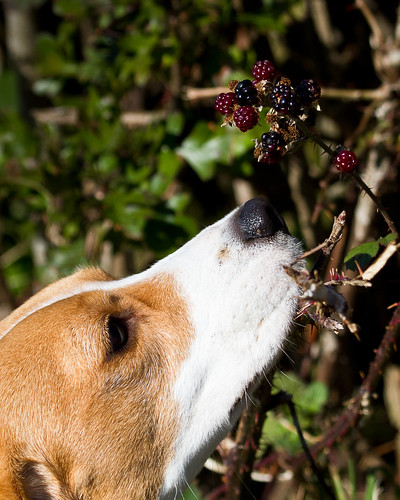It was a lovely sunny day today. We woke to blue skies, sunshine and crisp white frost over everything. We had a lovely morning walk in the country lanes around our house and the beaglets harvested the last of the blackberries.
We came home and had a fantastic agility practice session in the garden then indoors for a brekkie of lamb, garlic, sweet potato and courgettes. Now that’s what Beanie and Biggles call a great morning walk!
Both pups are doing really well in agility. We’ve been having a few lessons and Paul has now taken over as Biggles’ handler. We’re even thinking of entering some competitions but we do have some safety concerns.
Beanie and Biggles have had GPS tracking collars for a couple of years now. The collars can be used in lots of ways:
- You can set a virtual boundary around your property. If the dog leaves your property the collar sends you a text message and switches into tracking mode – it will keep sending you location updates. Those updates are displayed on a map on your phone so you can quickly get your dog home safely.
- On walks if your dog goes out of sight and you want to know where he is you simply send the collar a text message and it will respond by sending it’s location to your phone. Again, the dog’s location is displayed on mapping software on your phone so it’s very easy to find him.
Because of their capacity to get into trouble we prefer that our Beaglets don’t go out of sight at all. They’re always supervised in the garden and we simply don’t unclip their leads if we’re not confident that they’ll stay close. So we don’t use our collars in either of the above situations.
For us the collars come into their own when we do dog sports. In this situation we’re primarily relying on training – the dog knows it’s job and reliably follows our instructions. He *shouldn’t* go out of sight. However, we’re realistic. We know that it’s impossible to train away generations of selective breeding. No matter how well trained there is always a risk that a Beagle will revert to type and take off after a scent never to be seen again.
So, when we take part in sports that involve unclipping the lead Beanie and Biggles always wear their tracking collars. We rarely have to use them – we do our best to make sure the dogs are properly trained for their sports. But if something does go wrong and one of them runs off we have the peace of mind of knowing we’ll have them back safe and sound in minutes. This is particularly reassuring when we’re at events miles from home.
Paul hadn’t been keen on competition but he’s been enjoying working with Biggles and agreed at the weekend that he’d give it a try. But since looking into it more we’ve found out that there’s a bit of a show stopping problem. The Kennel Club rules state that the dog must wear a flat collar with no attachments or no collar at all (to reduce the risk of snagging on equipment). My guess is that the original ‘no collar’ rule is probably a throw back to other canine sports such as working trials. Gun dogs typically don’t wear collars because they have to crawl through the undergrowth and snagging would be highly likely. When agility was invented they probably ‘copied and pasted’ from rules from other sports. The risk of a dog’s collar snagging on agility equipment is negligible compared to the risk of a dog being off-lead in an unenclosed area perhaps miles from home and without a collar/id tag. Anyway, the ‘flat collar only’ rule was introduced a few years ago – BEFORE reliable GPS tracking collars were available. As the dog’s safety is the the driving force behind these rules I’m sure they’ll soon adapt the rule to include the use of GPS collars (I’ve contacted them to ask that it be reviewed). In the meantime we’ll try out a few charity competitions and see how the beaglets do.


